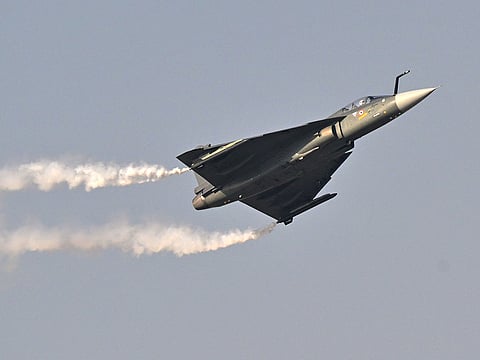Tejas crashes at Dubai Airshow: All about Indian Air Force combat aircraft
Single-engine Tejas light combat aircraft designed for defence and ground attack missions

India’s HAL Tejas light combat aircraft, which crashed at the Dubai Airshow, is the flagship of the country’s push to build a credible home-grown fighter capability.
Built by Hindustan Aeronautics Limited (HAL) in partnership with the Aeronautical Development Agency (ADA), the Tejas programme is central to India’s “Make in India” defence strategy, aimed at reducing dependence on foreign platforms.
The Tejas is a single-engine, multirole light combat aircraft (LCA) designed for air defence and ground-attack missions.
A key advantage is its agility: the aircraft uses a delta-wing configuration with no separate horizontal tailplane, making it compact, manoeuverable and suited to India’s varied operational environments. Its design emphasises low weight, high indigenous content and smaller logistic footprint compared to heavier fighters.
Key specifications – HAL Tejas Mk-1A
Manufacturer: Hindustan Aeronautics Limited (HAL) in collaboration with Aeronautical Development Agency (ADA)
Role: Single-engine, light multirole combat aircraft (LCA)
Length: 13.2 m
Wingspan: 8.2 m
Height: 4.4 m
Maximum Take-off Weight (MTOW): ~ 13,500 kg
Engine: GE F404-IN20 turbofan (single engine)
Maximum Speed: Around Mach 1.6 to Mach 1.8
Combat Radius: 500 km (typical strike/air-defence mission)
Ferry/Extended Range: Up to 1,850 km with external tanks (Mk-1A variant)
Payload Capacity: Up to 4,000 kg depending on load-out
Key upgrades in Mk-1A variant: AESA radar, electronic warfare suite, mid-air refuelling capability, higher indigenous content.
Orders grow
Production and orders have steadily grown. In February 2021, the Indian government approved a contract with HAL for 83 Tejas Mk 1A jets (73 single-seat + 10 trainers) at a cost of about Rs364 billion. More recently, HAL announced an agreement with the US-based General Electric for 113 F404-GE-IN20 engines — intended to power a follow-on lot of 97 more Tejas Mk 1A aircraft — with deliveries scheduled between 2027 and 2032. HAL itself has stated that increasing production capacity is a priority. A third production line in Nashik has been inaugurated, supplementing existing lines in Bengaluru, raising annual output prospects to about 24 jets.
Significant upgrades
In terms of capabilities, the Mk 1A variant carries significant upgrades over the original Mk 1: active electronically scanned array (AESA) radar, advanced electronic warfare suite, beyond-visual-range missiles, air-to-air refuelling capability and higher indigenous content.
These enhancements are designed to give the Indian Air Force (IAF) a modern, flexible platform suited to multi-role operations.
Strategically, the Tejas fills a vital gap for the IAF. With India retiring older types such as the MiG-21, MiG-27 and reducing dependence on foreign imports, the Tejas serves as a domestically-built workhorse that can be scaled in numbers and upgraded over time. It also helps India project technological self-reliance.
Sign up for the Daily Briefing
Get the latest news and updates straight to your inbox



